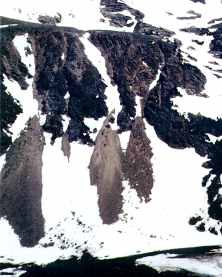|
Weathering, Erosion, and Mass Movement Slumps are characterized by a backward rotation of the earth
material as it moves along a curved failure plane resulting in a reverse
slope. Slumps take place as an int Figure 17.10 Slump on hill side.
Figure 17.11Solifluction terraces, Niwot Ridge, Colorado
A flow is the down slope movement of water-saturated soil, regolith, weak shale, or weak clay layers. Earth flows are fairly slow, occurring over a few hours or so slow that they are almost imperceptible. Earth flows are accompanied with slumping, but unlike slumping, there is no backward rotation. Earth flows differ from mudflows in that they (1) tend to be slower, (2) are not confined to channels, (3) are more common in humid areas than dry, and (4) have a lower water content.
A mudflow is the rapid down slope movement of water-saturated water- saturated soil, regolith. The higher water content creates a flow rapid enough to be perceptible to the eye. Conditions favorable for the development of mudflows are: (1) unconsolidated surface materials, (2) steep slopes abundant but intermittent precipitation, and (3) sparse cover of vegetation. Mudflows tend to be more prevalent in dry regions where vegetation is sparse and heavy rains may form. When set in motion, they occupy stream-cut channels rushing along in a torrential flow of mud.
Figure 17.13 Talus slope, Isabelle Valley, Colorado Rock fall is one of the most sudden forms of mass movement. Rock fall occurs when blocks of rock shed from a cliff face and collect at the base. Talus is a term that is applied to an accumulation of rock by rock fall.
Video:"Riding the Storm - Landslide Danger in San Francisco" |




